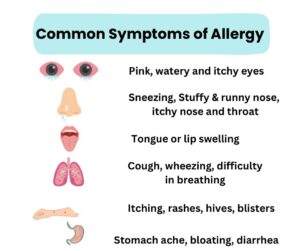Overview
Introduction
Allergies are a common health issue affecting millions of people worldwide. They occur when the immune system overreacts to normally harmless substances, known as allergens. This exaggerated response can lead to a variety of symptoms that range from mild to severe.
Definition
An allergy is defined as a hypersensitivity reaction of the immune system to specific substances that are typically harmless to most individuals. These reactions can manifest in various forms, including hay fever, food allergies, allergic asthma, and anaphylaxis.
Types of Allergies
There are several types of allergies, including:
Environmental Allergies: Triggered by pollen, dust mites, mold, and pet dander.
Food Allergies: Common allergens include peanuts, tree nuts, eggs, milk, soy, wheat, fish, and shellfish.
Insect Allergies: Reactions can occur from stings or bites from insects such as bees and wasps.
Medication Allergies: Certain medications, particularly antibiotics like penicillin, can trigger allergic reactions.
Latex Allergies: Exposure to latex products can cause allergic responses in sensitive individuals.
Causes and Risks
The development of allergies is influenced by both genetic and environmental factors. A family history of allergies or asthma increases the likelihood of developing allergic conditions. Environmental triggers include exposure to air pollution, cigarette smoke, and certain dietary factors. The immune system mistakenly identifies harmless substances as threats and produces IgE antibodies against them. Upon subsequent exposure to the allergen, these antibodies trigger the release of histamines and other chemicals from mast cells, causing symptoms.
Symptoms
Allergy can cause different symptoms as various organs of the body can react to an allergen. These symptoms can range from mild to severe depending on the allergen and the individual’s immune response. Here are some common symptoms associated with different types of allergies:
Environmental Allergies e.g. pollen, mould, dust etc:
• Sneezing
• Runny or stuffy nose
• Itchy or watery eyes
• Coughing
• Skin rashes or hives
Food Allergies:
• Nausea or vomiting
• Abdominal pain
• Diarrhea
• Swelling of the lips, tongue, or throat
• Anaphylaxis (a severe, potentially life-threatening reaction)
Insect Allergies:
• Localized swelling and redness at the sting site
• Itching or hives
• Anaphylaxis in severe cases
Medication Allergies:
• Skin rash or hives
• Difficulty breathing
• Swelling of the face or throat
Latex Allergies:
• Skin irritation upon contact with latex products
• Respiratory issues, such as sneezing and wheezing
• Anaphylaxis in severe cases

Diagnosis
Diagnosis of allergies typically involves:
Medical History: A thorough review of symptoms and potential triggers.
Skin Prick Test: This test involves placing small amounts of allergens on the skin to observe for reactions.
Blood Tests: Measuring specific IgE antibodies in the blood can help identify sensitivities.
Treatment
Treatment options for allergies vary depending on the severity and type of reaction:
Antihistamines: Medications such as loratadine or cetirizine can relieve mild symptoms like itching and sneezing.
Corticosteroids: Nasal sprays or oral medications can reduce inflammation in more severe cases.
Epinephrine: For life-threatening reactions such as anaphylaxis.
Avoidance Strategies: In addition to medication, avoiding known allergens is critical for managing symptoms effectively.
Prognosis
The prognosis for individuals with allergies varies widely. Many people experience mild symptoms that can be managed effectively with medication and lifestyle adjustments. However, some individuals may have severe allergic reactions that require emergency treatment. With appropriate management strategies in place, most people can lead normal lives despite their allergies.
Prevention
Preventing allergies involves minimizing exposure to known allergens and adopting certain lifestyle changes:
Avoidance: Identifying and avoiding allergens is crucial. For example, staying indoors during high pollen seasons or using dust mite-proof bedding for dust mite allergies.
Immunotherapy: Allergy shots or sublingual tablets can help desensitize individuals to specific allergens over time.
Healthy Environment: Keeping living spaces clean and free from mold and dust can reduce exposure to environmental allergens.
Coping with allergies
Living with allergies often requires ongoing management:
Education: Understanding one’s specific triggers is vital for avoidance and management.
Emergency Preparedness: Individuals with severe allergies should have an action plan in place for potential allergic reactions.
Support Groups: Connecting with others who have similar experiences can provide emotional support and practical advice.





